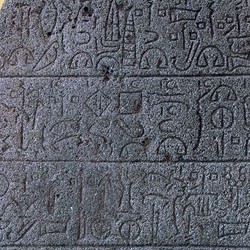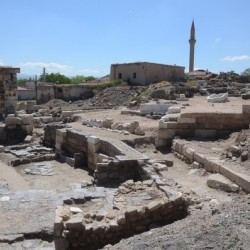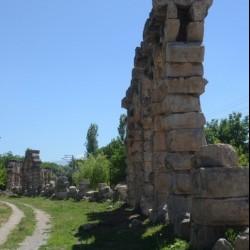Tyana (Kemerhisar)
Q1423615Tyana (Greek Τύανα; modern Kemerhisar): ancient town in southern Cappadocia.
Iron Age

Tyana was the main city of southern Cappadocia. Situated on a fertile plain, it had the potential to become a wealthy town, but it also controlled the route from central Anatolia to the Cilician Gate, through the Taurus Mountains, to the Mediterranean. It comes as no surprise that Tuhana or Tuwanna, to use its Luwian names, became the capital of an independent kingdom after the collapse of the Hittite Empire.
A famous relief from the eighth century BCE, cut in a rock near Ivriz, shows a modest king Warpalas of Tyana praying to the figure of a storm god Tarhunza, who is shown as a true giant. He is today best known as the logo of a Turkish wine brand. A similar relief, showing only the king, was found at Bor.
At some stage, the kingdom may have lost its independence to the Phrygians, while at the same time, Assyria was becoming increasingly powerful. According to the Annals of the Assyrian king Tiglath-pileser III, the city's king, a man named Ušhitti, paid tribute in an unknown year beween 745 and 737.
The city was a bridge between the two empires, for example when a king Mit-ta-a (who has - probably incorrectly - been identified with the legendary king Midas of Phrygia) negotiated with the Assyrian ruler Sargon II. King Warpalas of Tyana accompanied the envoy of Mit-ta-a across the Taurus mountains to the Assyrian governor of Cilicia.
Hellenistic City
After this, the kingdom disappears from our sources. However, we known that later, the city of Tyana was included in the Achaemenid satrapy of Katpatuka (or Cappadocia). The Athenian officer Xenophon, who passed through the town, calls it Dana. Alexander the Great must have passed through the city when he was heading for the Cilician Gate.
When Alexander's empire disintegrated, Tyana was first part of the kingdom of Antigonus the One-Eyed, and - after the battle of Ipsus in 301 BCE - of the Seleucid Empire. After more than a century, the city was handed over to Cappadocia (Peace of Apamea, 188) and renamed Eusebeia near the Taurus (Εὐσέβεια ἡ πρὸς τῷ Ταύρῳ), to honor the Cappadocian king Ariarathes IV Eusebes. Eusebia was the second city in Cappadocia after Mazaca, but the name was forgotten, and the town remained best known under its ancient name.
Roman City

In the Roman age, the city appears to have prospered. An aqueduct is still visible, and one of Tyana's sons, Apollonius, became a famous Pythagorean philosopher. There used to be a shrine for this pagan saint, which was built by the emperor Caracalla.note For the sake of this sanctuary, the emperor Aurelian refrained from sacking Tyana during his war against Palmyra.note
In 372, the province of Cappadocia was split, and Tyana became the capital of Cappadocia Secunda. The first Christian bishop is attested in 325. Tyana became a frontier city after the Muslim conquest of Cilicia, but lost much of its former importance.
 Bor, Relief of king Warpalas |
 Bor, Relief of king Warpalas, inscription |
 Tyana, City center (nymphaeum?) |
 Tyana, Aqueduct |